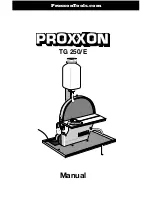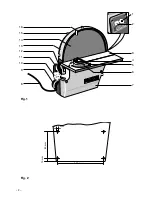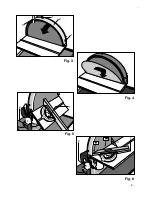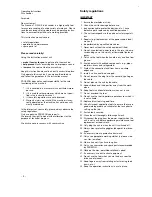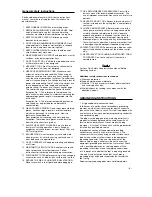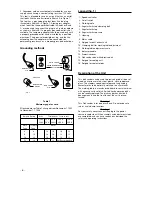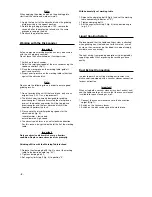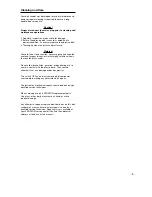
- 5 -
General safety instructions
Read and become familiar with this entire instructions
manual. Learn the tool`s applications, limitations and
possible hazards.
1. KEEP GUARDS IN PLACE and in working order.
2. REMOVE ADJUSTING KEYS AND WRENCHES. Form
habit of checking to see that keys and adjusting
wrenches are removed from tool before turning it on.
3. KEEP WORK AREA CLEAN. Cluttered areas and
benches invite accidents.
4. DON'T USE IN DANGEROUS ENVIRONMENT. Don't
use power tools in damp or wet locations, or expose
them to rain. Keep work area well lighted.
5. KEEP CHILDREN AWAY. All visitors should be kept
safe distance from work area.
6. MAKE WORKSHOP KID PROOF with padlocks, master
switches, or by removing starter keys.
7. DON'T FORCE TOOL. It will do the job better and safer
at the rate for which it was designed.
8. USE RIGHT TOOL. Don't force tool or attachment to
do a job for which it was not designed.
9. USE PROPER EXTENSION CORD. Make sure your
extension cord is in good condition. When using an
extension cord, be sure to use one heavy enough to
carry the current your product will draw. An undersized
cord will cause a drop in line voltage resulting in loss of
power and overheating. Table 1 shows the correct size
to use depending on cord length and nameplate
ampere rating. If in doubt, use the next heavier gage.
The smaller the gage number, the heavier the cord.
Exception No. 1: The reference to the table and the
table itself may be omitted if a statement indicating the
appropriate gage and length is incorporated into the
instruction.
Exception No. 2: The information regarding extension
cords need not be provided for a permanently
connected tool.
10. WEAR PROPER APPAREL. Do not wear loose clothing,
gloves, neckties, rings, bracelets, or other jewellery
which may get caught in moving parts. Non-slip
footwear is recommended.
Wear protective hair covering to contain long hair.
Exception: The reference to gloves may be omitted
from the instructions for a grinder.
11. ALWAYS USE SAFETY GLASSES. Also use face or
dust mask if cutting operation is dusty. Everyday
eyeglasses only have impact resistant lenses, they are
NOT safety glasses.
12. SECURE WORK. Use clamps or a vise to hold work
when practical. It's safer than using your hand and it
frees both hands to operate tool.
13. DON'T OVERREACH. Keep proper footing and balance
at all times.
14. MAINTAIN TOOLS WITH CARE. Keep tools sharp and
clean for best and safest performance. Follow
instructions for lubricating and changing accessories.
15. DISCONNECT TOOLS before servicing; when changing
accessories, such as blades, bits, cutters, and the like.
16. REDUCE THE RISK OF UNINTENTIONAL STARTING.
Make sure switch is in off position before plugging in.
17. USE RECOMMENDED ACCESSORIES. Consult the
owner's manual for recommended accessories. The
use of improper accessories may cause risk of injury to
persons.
18. NEVER STAND ON TOOL. Serious injury could occur if
the tool is tipped or if the cutting tool is unintentionally
contacted.
19. CHECK DAMAGED PARTS. Before further use of the
tool, a guard or other part that is damaged should be
carefully checked to determine that it will operate
properly and perform its intended function check for
alignment of moving parts, binding of moving parts,
breakage of parts, mounting, and any other conditions
that may affect its operation. A guard or other part that
is damaged should be properly repaired or replaced.
20. DIRECTION OF FEED. Feed work into a blade or cutter
against the direction of rotation of the blade or cutter
only.
21. NEVER LEAVE TOOL RUNNING UNATTENDED. TURN
POWER OFF. Don't leave tool until it comes to a
complete stop.
Warning
For Your Own Safety Read Instruction Manual Before
Operating Sander
Additional safety instructions for sander:
a) Wear eye protection.
b) Support workpiece on worktable.
c) Maintain 1/16 inch maximum clearance between table
and sanding belt or disc.
d) Avoid kickback by sanding in accordance with the
directional arrows.
GROUNDING INSTRUCTIONS:
1. All grounded, cord-connected tools:
In the event of a malfunction or breakdown, grounding
provides a path of least resistance for electric current to
reduce the risk of electric shock. This tool is equipped with
an electric cord having an equipment-grounding conductor
and a grounding plug.
The plug must be plugged into a matching outlet that is
properly installed and grounded in accordance with all
local codes and ordinances. Do not modify the plug
provided – if it will not fit the outlet, have the proper outlet
installed by a qualified electrician.
Improper connection of the equipment-grounding
conductor can result in a risk of electric shock. The
conductor with insulation having an outer surface that is
green with or without yellow stripes is the equipment-
grounding conductor. If repair or replacement of the
electric cord or plug is necessary, do not connect the
equipment-grounding conductor to a live terminal. Check
with a qualified electrician or service personnel if the
grounding instructions are not completely understood,
or if in doubt as to whether the tool is properly grounded.
Use only 3-wire extension cords that have 3prong
grounding plugs and 3pole receptacles that accept the
tool's plug.
Repair or replace damaged or worn cord immediately.

